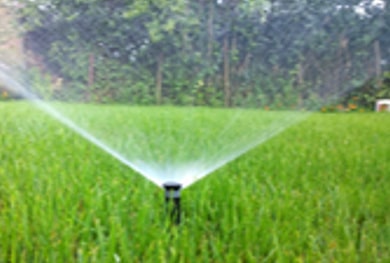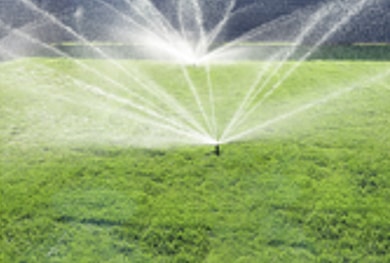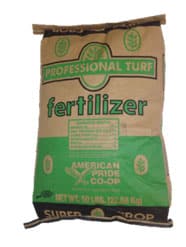Watering Established Turf
There is simply no way to publish a one-size-fits-all maintenance guideline for established lawns (lawns over 1 year old). Watering, fertilizing, and mowing frequencies are a function of many variables including soil type, sun exposure, traffic, weather, desired turf performance, type of turf and probably a dozen more variables that I haven’t listed. The overriding goal of turf maintenance is to balance the goals that we have for the turf area with the time and resources that we want to put toward that space. The grasses that we grow for sod will accommodate a wide range of maintenance programs and will survive and thrive at varying levels based on the inputs that they receive. A lush, near perfect turf will require higher maintenance than an acceptable but not perfect turf.
Watering
On established turf, irrigation rates can vary wildly. For a lush green cool season turf lawn during the hottest part of the summer watering “requirements” may be as high as 2” of water (irrigation + useable rainfall) per week. That same turf may be able to get by on half that amount of water or less if the homeowner is content with slightly reduced aesthetic goals. Traffic also plays a part in water requirements to maintain a healthy lawn. Greater traffic generally requires elevated levels of irrigation and fertilization. On established turf water deeply but infrequently. This will help promote deep roots which are essential for capturing the benefit from rain. Also be diligent about turning the sprinkler off when significant rains happen. Saving water not only benefits the community but also reduces watering and fertilizer costs. Initial soil prep is critical in reducing lawn water use over time. With a good soil watering 2 or 3 times a week is typical.
When to Water
To help reduce evaporation and drift water in the early morning. This ensures that more water makes it to the plant and less gets lost to evaporation. Although watering during the day is not detrimental to the turf, it is inefficient and more costly to water when the sun and wind are significant factors. Water when the grass needs it. Often the grass tends to change color subtly as it physiologically needs water. The grass will show a darker, blackish color when it is needing irrigation. Listen to your lawn and water when it asks for it.
How Long to Water
The irrigation duration is dependent on type of sprinkler that is being used and the amount of water that the grass needs. Keep in mind that pop-up spray sprinklers distribute twice as much water per set time than do pop-up rotor sprinklers. For this reason rotors and sprays should always be on separate zones and the run times should reflect the 2:1 output difference. Also because the grass needs more water in the heat of the summer adjust your sprinkler run times to reflect the changes in seasons and weather. Do not water the same amount in April as in July.
Troubleshooting Sprinkler Performance
One of the greatest tools to diagnose water related lawn problems is a set of collection cups. Setting up collection cups in various parts of the lawn will often tell an important story. Be sure and place one cup in the area having trouble and then at least one cup in an area that looks good. Next, run your sprinkler and see if there is a disparity in the amount of water in each cup. More often than not you will see less water in the cup in the distressed are than in the other cups. With this information you can then adjust your sprinkler system coverage to give you the lawn you are looking for.
Condition
Month |
Lush (near perfect) |
Acceptable |
Healthy But Diminished |
|---|---|---|---|
| March | .5” per week | 0” per week | 0” per week |
| April | .75” per week | .5” per week | 0” per week |
| May | 1.0” per week | .75” per week | .5” per week |
| June | 1.25” per week | 1” per week | .75” per week |
| July | 1.5” per week | 1.2” per week | 1.0” per week |
| August | 1.4” per week | 1.1” per week | .9” per week |
| September | .9” per week | .7” per week | .6” per week |
| October | .4” per week | .3” per week | .2” per week |
| November | .2” per week | 0” per week | 0” per week |
Typical sprinkler precipitation assumptions





